Rehmanniae Radix Praeparata aqueous extract improves hepatic ischemia/reperfusion injury by restoring intracellular iron homeostasis
IF 4
2区 医学
Q1 INTEGRATIVE & COMPLEMENTARY MEDICINE
引用次数: 0
Abstract
Hepatic ischemia/reperfusion injury (HIRI) is a common pathophysiological condition occurring during or after liver resection and transplantation, leading to hepatic viability impairment and functional deterioration. Recently, ferroptosis, a newly recognized form of programmed cell death, has been implicated in IRI. Rehmanniae Radix Praeparata (RRP), extensively used in Chinese herbal medicine for its hepatoprotective, anti-inflammatory, and antioxidant properties, presents a potential therapeutic approach. However, the mechanisms by which RRP mitigates HIRI, particularly through the regulation of ferroptosis, remain unclear. In this study, we developed a HIRI mouse model and monocrotaline (MCT)- and erastin-induced in vitro hepatocyte injury models. We conducted whole-genome transcriptome analysis to elucidate the protective effects and mechanisms of RRP on HIRI. The RRP aqueous extract was characterized by the presence of acteoside, rehmannioside D, and 5-hydroxymethylfurfural. Our results demonstrate that the RRP aqueous extract ameliorated oxidative stress, reduced intracellular iron accumulation, and attenuated HIRI-induced liver damage. Additionally, RRP significantly inhibited hepatocyte death by restoring intracellular iron homeostasis both in vivo and in vitro. Mechanistically, the RRP aqueous extract reduced intrahepatocellular iron accumulation by inhibiting ZIP14-mediated iron uptake, promoting hepcidin- and ferroportin-mediated iron efflux, and ameliorating mitochondrial iron aggregation through upregulation of Cisd1 expression. Moreover, siRNA-mediated inhibition of hamp synergistically enhanced the RRP aqueous extract’s inhibitory effect on ferroptosis. In conclusion, our study elucidates the mechanisms by which RRP aqueous extracts alleviate HIRI, highlighting the restoration of iron metabolic balance. These findings position RRP as a promising candidate for clinical intervention in HIRI treatment.
熟地黄水提取物通过恢复细胞内铁稳态改善肝缺血再灌注损伤
肝脏缺血/再灌注损伤(HIRI)是一种常见的病理生理状况,发生在肝脏切除和移植过程中或之后,会导致肝脏活力受损和功能衰退。最近,一种新认识到的程序性细胞死亡形式--铁蛋白沉积(ferroptosis)被认为与 IRI 有关。地黄(RRP)因其保肝、抗炎和抗氧化特性而被广泛应用于中药中,是一种潜在的治疗方法。然而,RRP 减轻 HIRI 的机制,特别是通过调节铁蛋白沉积的机制,仍不清楚。在本研究中,我们建立了一个 HIRI 小鼠模型以及单克隆(MCT)和厄拉斯汀诱导的体外肝细胞损伤模型。我们进行了全基因组转录组分析,以阐明 RRP 对 HIRI 的保护作用和机制。RRP 水提取物的特征是含有阳起石苷、雷曼牡蛎苷 D 和 5- 羟甲基糠醛。我们的研究结果表明,RRP 水提取物能改善氧化应激,减少细胞内铁积累,减轻 HIRI 引起的肝损伤。此外,通过恢复细胞内铁的体内和体外平衡,RRP 还能显著抑制肝细胞的死亡。从机理上讲,RRP 水提取物通过抑制 ZIP14 介导的铁吸收、促进肝磷脂素和铁蛋白介导的铁外流,以及通过上调 Cisd1 的表达改善线粒体铁聚集,从而减少肝细胞内铁的积累。此外,siRNA 介导的对 hamp 的抑制协同增强了 RRP 水提取物对铁蛋白沉积的抑制作用。总之,我们的研究阐明了 RRP 水提取物缓解 HIRI 的机制,强调了铁代谢平衡的恢复。这些研究结果将 RRP 定位为治疗 HIRI 的临床干预候选药物。
本文章由计算机程序翻译,如有差异,请以英文原文为准。
求助全文
约1分钟内获得全文
求助全文
来源期刊

Chinese Journal of Natural Medicines
INTEGRATIVE & COMPLEMENTARY MEDICINE-PHARMACOLOGY & PHARMACY
CiteScore
7.50
自引率
4.30%
发文量
2235
期刊介绍:
The Chinese Journal of Natural Medicines (CJNM), founded and sponsored in May 2003 by China Pharmaceutical University and the Chinese Pharmaceutical Association, is devoted to communication among pharmaceutical and medical scientists interested in the advancement of Traditional Chinese Medicines (TCM). CJNM publishes articles relating to a broad spectrum of bioactive natural products, leading compounds and medicines derived from Traditional Chinese Medicines (TCM).
Topics covered by the journal are: Resources of Traditional Chinese Medicines; Interaction and complexity of prescription; Natural Products Chemistry (including structure modification, semi-and total synthesis, bio-transformation); Pharmacology of natural products and prescription (including pharmacokinetics and toxicology); Pharmaceutics and Analytical Methods of natural products.
 求助内容:
求助内容: 应助结果提醒方式:
应助结果提醒方式:


